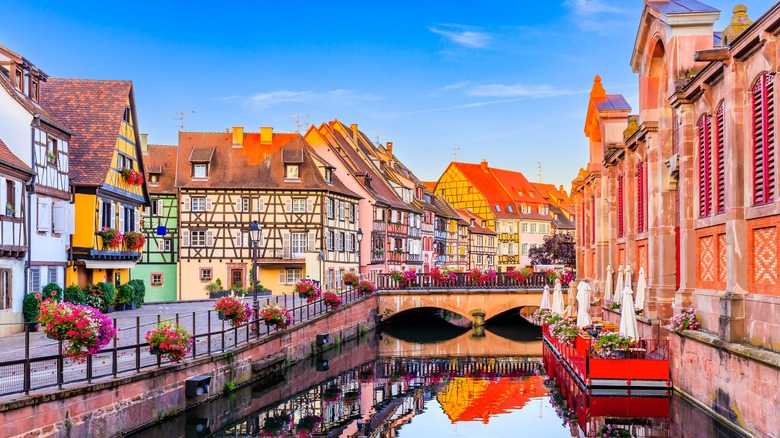Can't Decide Between Visiting France Or Germany? Here's What Rick Steves Recommends
As far as land mass goes, France and Germany are two of the largest countries in Western Europe. They are also home to some of the world's most popular tourist destinations. While the two countries share a border, finding time to visit hotspots in both of these countries might be a squeeze. However, there are places with influences of both countries due to intertwined histories. Alsace, a region in eastern France, borders Germany, and although there is a clear border between France and Germany on maps, the history of this region makes Alsace a somewhat disputed grey area.
European travel expert Rick Steves has met with residents in Alsace. "Germany believes the correct border is the mountains behind us. And we French believe [it is] the Rhine," Jean-Claude Schumacher (whose name perfectly sums up the blend of French and German influence) told Steves, per his website. "That's why Alsace changes sides with each war. That's why we are a mix of France and Germany." Past wars during which Alsace fell under German control include the Franco-Prussian War, World War I, and World War II. Despite varying opinions on borders, Alsace is simply a beautiful region with plenty to offer.
Strasbourg is historic and pedestrian friendly
The largest city in Alsace, Strasbourg is known for the unique district of Grande-Île de Strasbourg, a section of the city that's surrounded by small tributaries connected to the Rhine River. This area features quaint pedestrian-only streets, restaurants and shops housed in pastel buildings, as well as many iconic landmarks. The massive Cathédrale Notre-Dame-de-Strasbourg is hard to miss, and the Ponts Couverts de Strasbourg, which are the bridges and towers of the district, serve as symbols of the Strasbourg Republic's independence before the region became part of France in 1681. You can also head to Barrage Vauban, a dam built in front of Ponts Couverts de Strasbourg, for wide views of the city.
France's museums are often located in historic buildings, and those in Strasbourg are no exception. In the southern part of Grande-Île de Strasbourg is the 18th-century Palais Rohan. It was built for Cardinal Armand-Gaston de Rohan-Soubise, Prince-Bishop of Strasbourg, but now houses three museums: the Archaeological Museum, the Fine Arts Museum, and the Decorative Arts Museum. The latter of these showcases the living quarters of the cardinals who once lived here.
Colmar is Rick Steves' favorite city in Alsace
A 25-minute train ride from Strasbourg leads to another reminder of Germany's past ownership of the Alsace region. Fort de Mutzig, or Feste Kaiser Wilhelm II, was the German Empire's biggest military fort in the early 20th century. Tours include multiple artillery and observation turrets, underground tunnels, and living spaces for the servicemen. Advance booking is not required, but can be done online. The Mutzig train station is two miles from the fort itself, but the walk is peaceful with countryside views.
Colmar is a smaller city in Alsace and a Rick Steves favorite. "Colmar is alive with colorful buildings, impressive art treasures, and enthralled visitors," he explains on his website. Its long, thin canal incorporates photogenic spots like the Pont Rue des Ecoles bridge and plenty of half-timbered buildings. As for the art scene, Colmar's Musée Unterlinden has art from the Middle Ages through the 21st century. Eateries in Colmar like Restaurant Hammerer and Restaurant Caveau Saint-Pierre serve the region's fusion cuisine, such as cordon bleu with sauerkraut. All aspects of Alsatian culture form the perfect combination of France and Germany. "Alsace is a powerful example of the high culture, cuisine, and art that results when two great nations mix it up," says Steves.


